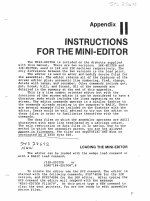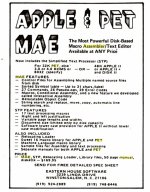Hugo Holden
Veteran Member
I found this manual on the PET Assembler:
(I assume this is suited to my PET ?)
And since it is invoked by SYS36864, clearly it is supposed to live in a ROM in position D3.
Does anybody know where the .BIN file is for this assembler ROM, that matches up with the attached document ?
(I had a look on Zimmers, but I don't want to get the wrong file)
It also looks like the Loader is in a ROM D4 and it requires a special edit ROM too to make the Editor work, but I'm not certain. Any advice much appreciated.
(I assume this is suited to my PET ?)
And since it is invoked by SYS36864, clearly it is supposed to live in a ROM in position D3.
Does anybody know where the .BIN file is for this assembler ROM, that matches up with the attached document ?
(I had a look on Zimmers, but I don't want to get the wrong file)
It also looks like the Loader is in a ROM D4 and it requires a special edit ROM too to make the Editor work, but I'm not certain. Any advice much appreciated.
Last edited:



